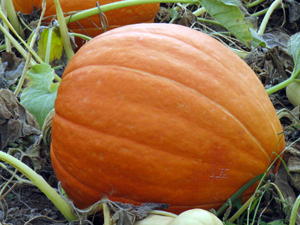How to Pick the Perfect Pumpkin
Return to Vegetables Agent Articles
 Pumpkins and other fall items make autumn one of the most fun seasons for decorating. The centerpiece of autumn décor is the popular pumpkin.
Pumpkins and other fall items make autumn one of the most fun seasons for decorating. The centerpiece of autumn décor is the popular pumpkin.
Picking the right pumpkin in many ways is a personal preference as beauty is in the eye of the beholder. Round, squatty, oblong, with or without scratches — they all have their own character.
How to pick a pumpkin: What to look for
When choosing a pumpkin, look closely at the flesh of the orb. Avoid any pumpkins that have cracks or splits. Gently squeeze or press your fingers into the fruit. Pay close attention to the blossom end, or bottom, and around the stem. A fresh pumpkin should be solid to the touch. Avoid ones that have soft spots or sunken areas, as decay has already set in.
Selecting good quality produce will ensure that your autumn display will be long lasting. High quality pumpkins have a firm, hard rind and are generally rich orange in color. Color is not always the best indicator of maturity, as pumpkins now come in varying shades from bright orange to light orange to almost white.
Test for the maturity of a pumpkin by gently pressing your fingernail into the rind. A mature pumpkin will resist scratching. If the surface is easily penetrated, the pumpkin was picked too early and will end up rotting. Immature pumpkins do not have a long life once picked. Also check for firm, bright green stems as this indicates freshness. A dry, shriveled stem usually means the pumpkin has been picked and stored for a long period of time thus reducing its ability to remain fresh throughout the entire fall decorating season.
Carry your pumpkin in your arms, not by the stem
Holding or carrying a pumpkin should be done with care. Avoid the temptation to carry the pumpkin by the stem. The stem is not a built-in handle. Once the stem breaks off, pumpkin decay is not far behind. The stem’s connection to the pumpkin is not strong enough to support the weight of the fruit. Although more awkward, grasp your hands or arms around the orange globe and carry it from the bottom.
Match the pumpkin to its purpose
Pick the right pumpkin for the job. Of course perfect can mean a lot of things. Sometimes we are drawn to flat, tall, or squatty — just about any shape to get us into the fall festive mood. But if you plan on carving a jack-o-lantern, select a large, uniform shaped pumpkin as this will maximize your creativity. If pumpkin pie or a squash dish is the fruits destiny, then choose small, heavy fruits (sometimes marketed as pie pumpkins or winter squash because they contain more pulp than the larger varieties.
How to make your pumpkin last longer
Pumpkins store best under cooler conditions. Either in the home or outdoors, they will keep for several months. Hard freezes late in the season will damage outdoor pumpkins causing them to turn to mush. Some recommend wiping the fruit off with a solution of bleach water to reduce rot and decay. This is normally not necessary but can be done.
Picking pumpkins is a great family activity and a fun way to celebrate the season.
Have questions? The Garden Hotline is staffed by trained EMG volunteers and Extension staff who will assist you with questions.
Phone: (913) 715-7050
Email: garden.help@jocogov.org